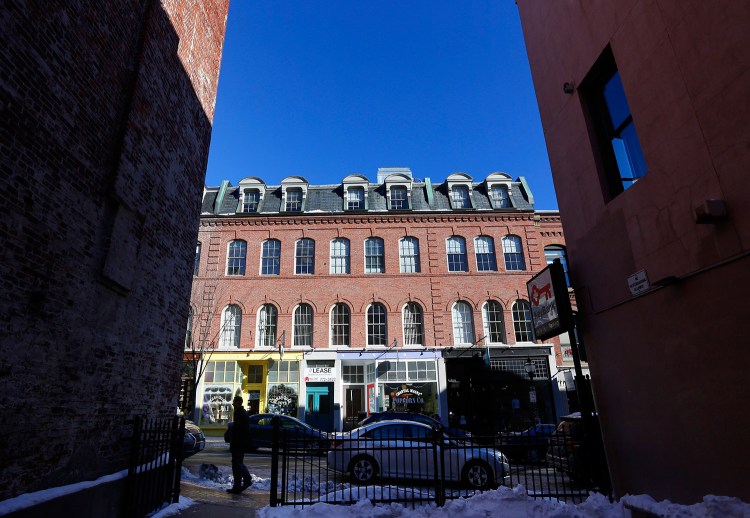Portland’s “no vacancy” problem extends well beyond rental housing.
A frenzy of commercial real estate transactions in 2015 has left very little available space in the city’s industrial, retail and office zones, according to analysts who spoke before a packed house of real estate professionals in Portland Thursday.
Supply is so scarce that businesses seeking prime locations have found nowhere to go, they said, a situation that is likely to persist until new development occurs.
“We are full, and we need more inventory,” said commercial real estate broker Justin Lamontagne of NAI The Dunham Group in Portland, which specializes in the industrial sector.
Available space in Portland-area industrial zones has become increasingly scarce over the past few years, in part because those properties have become desirable spots for breweries, coffee shops, medical marijuana providers and other retail-oriented businesses, Lamontagne told a record crowd of more than 800 at Thursday’s Maine Real Estate & Development Association conference at Holiday Inn by the Bay.
The vacancy rate for commercial properties in greater Portland’s industrial zones was an “absurdly low” 3.4 percent at the end of 2015, he said, down from an already tight 4.1 percent a year earlier.
Lamontagne said 2015 was “the busiest, most vibrant year in the industrial sector that I’ve ever seen in my career.”
Still, the ultra-low vacancy rate did not spur new construction or cause rents to increase much, he said. Lease rates in greater Portland averaged $5.62 per square foot per year plus the property tax, insurance and maintenance costs, which is less than both the U.S. average of $5.88 and the Northeast regional average of $5.71.
Lamontagne predicted that speculative development will occur in 2016, increasing the availability of industrial space, and that lease rates will climb above $6 per square foot per year.
Like its industrial sector, Greater Portland’s retail real estate scene is much stronger than the nation’s as a whole.
While the U.S. average retail vacancy rate hovered around 12.6 percent in 2015, Portland and its suburbs had a rate of 3.6 percent – a figure that would have been even lower if not for the nearly 14 percent vacancy rate at the Falmouth shopping center on Route 1.
The lease rates for retail space increased 22 percent from 2014 to 2015, according to an analysis presented by Karen Rich of Cardente Real Estate. Overall lease rates averaged $17.62 per square foot per year, with prime rates increasing 68 percent while secondary markets dropped 4 percent over the year.
The most robust retail market is in the Old Port, where leases range from $25 to $35 per square foot for space in the 1,200-1,800 square-foot range. The vacancy rate for Commercial, Fore and Exchange streets is almost zero, according to Rich.
One reason for that is a seemingly endless string of restaurant openings, she said. So many restaurants have sought spaces in Portland that the definition of “Old Port” has been expanded northeast all the way to Washington Avenue, where a string of new eateries opened in 2015.
“And they all seem to be doing well,” Rich said.
The supply of prime office space in downtown Portland has dwindled to the point where landlords in 2015 didn’t need to negotiate on prices or offer concessions such as paying for tenant improvements, said presenter Nate Stevens, associate broker at CBRE|The Boulos Co.
“We saw landlords really in the driver’s seat in a lot of these deals,” he said.
Another hot spot for office property sales and leases was the area around the Maine Mall in South Portland, Stevens said, where more than half the Portland area’s prime office supply is located.
Demand for property in those areas helped spur record sale transactions and drive the area’s vacancy rate for prime, “Class A” office space down to 4.5 percent as of Dec. 1 from an already low 5.8 percent at the end of 2014, according to the Boulos report.
Stevens predicted a continued drop in the vacancy rate, particularly among the less desirable “Class B” properties, which in some instances are being refurbished to make them more competitive with the rest of the market.
New office construction is likely in prime zones such as downtown Portland, Stevens said, adding that he expected lease rates to increase only slightly.
The volume of sale transactions is bound to decrease, he said, simply because some of the metro area’s largest and most expensive properties changed hands in 2015.
“It’s going to be extremely hard to top (2015) in investment office sales,” Stevens said.
Send questions/comments to the editors.




Success. Please wait for the page to reload. If the page does not reload within 5 seconds, please refresh the page.
Enter your email and password to access comments.
Hi, to comment on stories you must . This profile is in addition to your subscription and website login.
Already have a commenting profile? .
Invalid username/password.
Please check your email to confirm and complete your registration.
Only subscribers are eligible to post comments. Please subscribe or login first for digital access. Here’s why.
Use the form below to reset your password. When you've submitted your account email, we will send an email with a reset code.